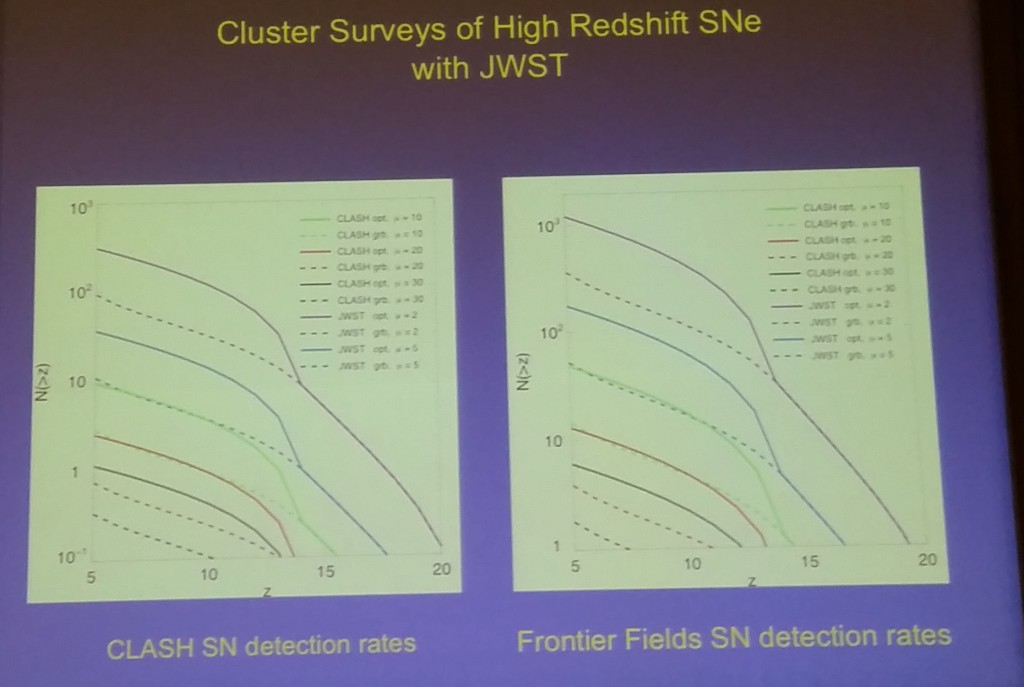Conference (website) at the Institut d’Astrophysique de Paris, 7-10 December 2015
Monday (07 Dec 2015)
Bahcall – Lighting up the Dark: Where is the Dark Matter?
- Old concept (Ostriker+ 1974, Davis+ 1980): M/L increases with mass scale. Larger systems are dominated by DM.
- Local M/L values (Bahcall & Kulier 2014): mass and light follow each well within galaxy clusters out to several r200.
- Stellar mass fraction in clusters is ~1%
Ostriker – Choosing the nature of DM to address small scale structure dramatically changes early galaxy formation
- Precision cosmology matches nearly all large-scale observations very well. What about small-scale features? Can differences in early galaxies be accounted to different DM particles?
- Exploring a model with m_DM = 1.2 x 10^-22 eV, which suppresses galaxy formation in halos with M < 10^9 Msun
Haiman – Forming massive seed BHs at high-z
- Obstacles in forming DCBHs: H2 cooling, radiation feedback, and fragmentation
- J21 = (1,10) at z ~ (3, reionization)
- Talked about close pairs (Visbal+ 2014) and the hyper-accretion (Inayoshi+ 2015) papers.
Alexander – Supra-exponential growth of seed BHs in the early universe
- Model considers a small stellar cluster in a high-z dense cold
flow. Atomic cooling halo. Can this sustain high accretion flows? - A stellar-mass BH orbits around in a dense stellar cluster,
accreting. There is unavoidable accretion, inducing a flow
(velocity gradient induced by acceleration, and density gradient due to the non-central position). - Overcoming the AM barrier: deceleration by accretion drag. Variable mass changes momentum; damped harmonic oscillator. As the mass grows, the BH decelerates and falls into the center.
- Low efficiency of AM accretion leads to a self-regulating capture from an inhomogeneous wind (2D treatment from Davies & Pringle 1980)
- This mode is applicable to 10^4 Msun within ~30 Myr.
Broadhurst – Comparison of the latest Hubble Data with the first simulations of Bosonic DM for the “No-WIMP” Era
- Fine granularity for very light DM particles, named Wave-DM (ΨDM).
- The field evolves by interacting with itself under the action of its own gravity. Light bosons are opposite of WIMPs.
- Motivated by suppressing galaxy formation in low-mass halos instead of relying on feedback effects.
- (Perley+ 2015) Long GRBs at high-z. Lack of them when compared to galaxy observations?
- Large-scale structure is similar to WDM, but Wave-DM is granular at small-scales and could be tested with gravitational lensing.
Becker – Reionization: What we know from quasar absorption lines
- Absorption lines probe
- (z<6) Ionizing photon budget, thermal history, Jeans smoothing
- (z~6) f_HI fluctuations, metal lines
- (z>6) f_HI from QSO near zones
- Varying f_HI in z ~ 6 QSO sight lines. Could it be caused
- during the post-overlap phase (Gnedin & Kaurov 2014),
- UVB fluctuations due to QSOs (Chardin+ 2015),
- a “natural” mfp fluctuations (Davies & Furlanetto 2015), or
- temperature fluctuations from reionization (D’Aloisio+ 2015).
- How to improve? More precise UVB measurements at z=2-5; extend emissivity measurements to z ~ 6, directly connect galaxies and the IGM, IGM temperatures at z~6, etc.
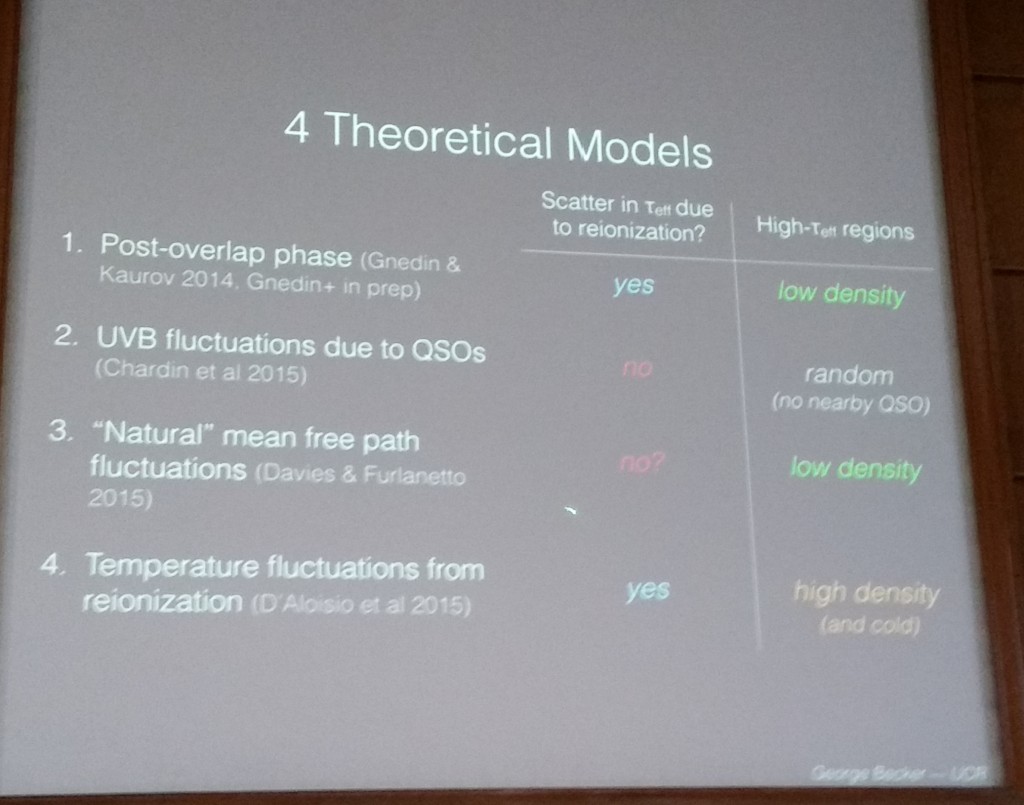
Bovill – Detecting first light with the JWST
- JWST Cycle 1: Feb 2018; Scheduled launch date: Oct 2018
- (Taylor+ 2015) GC populations of Cen A.
- (Bovill+ in prep) They have similarities to uFds but have high central stellar densities that could be explained by a central MBH.
Yoo – Relativistic effect in galaxy clustering as a novel probe of cosmology
- Use Optical/NIR/21cm observations to constrain galaxy formation and large-scale structure. Can be used to test inflationary processes.
- GR effects in galaxy clustering? Can be tested with grav. redshifting, lensing, and other things that I missed.
- GR effects is significant (order unity) at the horizon scale @ the source redshift, thus it becomes more important at high-z.
- Deviations from standard cosmology: fossil fields, DE fluctuations
Treu – The first galaxies through a magnifying GLASS
- (Zitrin+ 2015) Current LAE redshift record holder
- (Treu+ 2013; Tilvi+ 2014) Is the decline in LAEs with increasing redshift a consequence of reionization?
- GLASS: Focusing on faint source grism spectra
- Spectrum of everything in the FoV
- Excellent photometry, uninterrupted wavelength coverage, etc.
- (Schmidt+ 2015) Spectra of 159 LBGs at z>7, currently being followed up with Keck and VLT (Mason’s talk).
Windhorst – HST observations of escaping LyC radiation from galaxy and weak AGN (z = 2.3-5)
- (Cen & Kimm 2015) Stacked PDFs of f_esc and smooth curves reduce to a Heaviside step function at the mean value of f_esc
- In a collaboration across f_esc observer groups, they produced a “gold” sample with accurate redshifts. The sample is incomplete at m_AB > 24 (M_1400 < -21).
- In the UV continuum, the surface brightness profiles are not Sersic. Very clumpy when stacking everything (N = 50 in the gold sample and N = 114 in Gold+Silver sample)
- This is likely a sum of a handful of “clear” lines of sight through an ionized channel, caused by a porous ISM.
- At z ~ 2, the galaxies with continuum rad has a broad range of extincition, but the z>3 galaxies have mostly low extinctions (~0.2 mag)
- (Inoue+ 2014) They find that f_esc ~ 10% (z=4), and high uncertainty at z=5, but only ~1% at z ~ 2-3.
Shapiro – Simulating reionization and its observable consequences
- (Park+ 2015) Looking at the evolution of the clumping factor when a box is evolved in a UV background with shielding (RT).
Aubert – Looking at galaxy populations during reionization using cosmological simulations
- Has run several 8 Mpc/h 256^3 simulations with different physical models. Reasonable agreement with reionization constraints.
- The peak in cosmic SFR comes from 10^10 solar mass halos at z=6.
- Sees flattening above M_AB = -14.
- Increasing UV emissivity leads to earlier reionization but the same cSFR.
- Source discreteness: enables studying SF burstiness and stochasticity. However the flattening of the LF is still there.
Tuesday (08 Dec 2015)
Kamionkowski – Intensity mapping with CO (and other) lines
- Use the power spectrum and 1-pt PDF of CO and 21cm fluctuations to learn about the cSFR and reionization histories. Can be used with any emission line (e.g. CII, HeII, Ly-alpha, etc)
- At low-k, it’s dominated by the actual signal but is dominated by shot noise at high-k. To ascertain anything about the small-scale, one needs a good description of the shot noise.
- For CII lines, higher CO lines at low-z are the foreground. For CO lines, HCN lines are the contaminant.
- (Breysse+ 2015) Use CO lines to calculate a cSFRD.
- Intensity line mapping can be used to constrain LSS, BAO, and DE tests.
Haehnelt – Probing the end of hydrogen reionization with Lyman-alpha absorption
- (Chardin+ 2015) Used a post-processing 20 Mpc/h box (with RAMSES and ATON) to probe the Ly-alpha forest evolution during and after reionization.
- (Chardin) Photon emissivity is well re-produced with a modified version of HM12. However, the opacity and photo-ionization rate PDFs are too peaked. Can larger scale fluctuations fit the opacity PDF, i.e. bigger than their box size (20 Mpc/h)?
- Suggests that there needs to be more contribution from AGN to the photoionization rate at z > 4 (see Giallongo+ 2015).
- (Chardin+ in prep) There are very large-scale fluctations from QSOs on the order of 100-500 cMpc!
- Also see Davies and Furlanetto (2015). Very short mfp (15 cMpc) in underdense regions.
- (D’Aloisio+ 2015) Large-scale fluctuations. Appears to work, but there is an uncomfortably early IGM heating.
Chang – 21cm Intensity Mapping
- Current efforts at low-z (z~1) for BAO and (z>6) for reionization.
- Pilot program for BAO campaign at Green Bank. Already used to make a cross-correlation with galaxies at z=0.8 (Chang+ 2008)
- Have measured Omega_HI*b_HI = 0.62[err:+0.23-0.15] x 10^-3 at Green Bank.
- (Lidz+ 2011) CO/CII line intensity mapping, using simulations (?). HI-CO anti-correlates on large-scales, constraining size evolution of ionized regions.
Mashian – Predicting the intensity mapping signal for multi-J CO lines in the early universe
- (Mashian+ 2014) Calculate the SFR-halo mass relation for different redshifts.
- Need to assume steady state (statistical equilibrium) in a 2-level system. Use an escape probability approximation for the emission line. If dv/dr is larger than the line width, then the photon is only reabsorbed near the source.
- For Mhalo = 10^8-10 Msun, the CO emission peaks at J_upper=4-5. But above these masses, the lines are strong up to J_upper = 13.
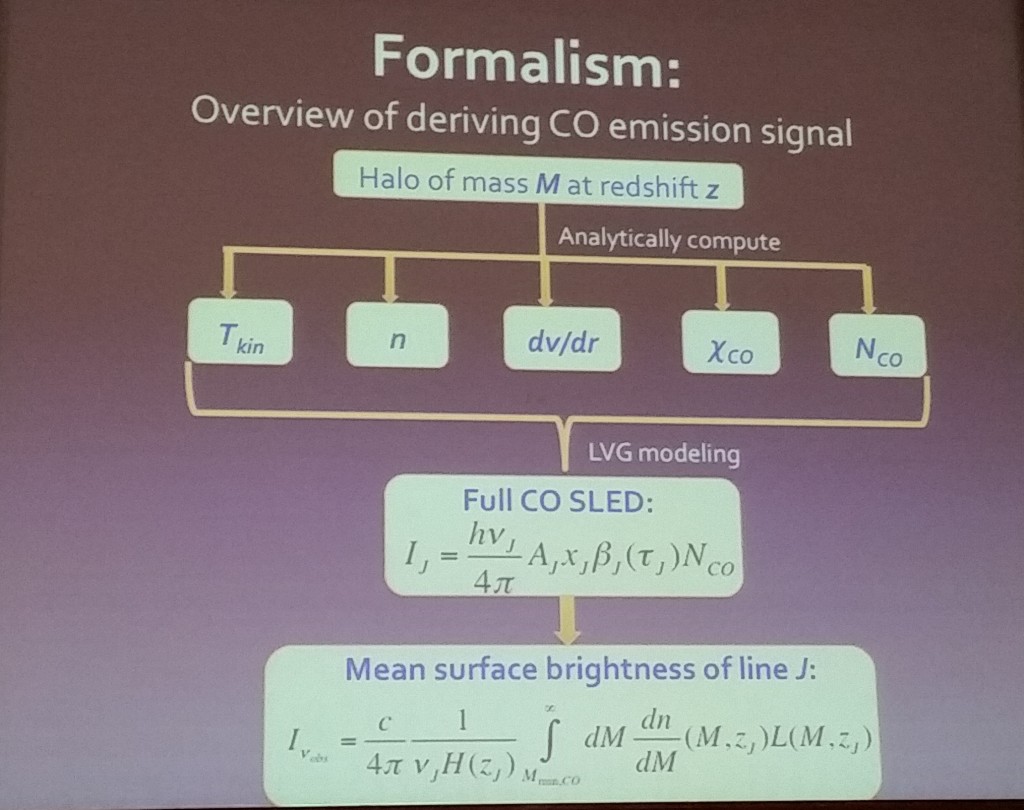
Mesinger – Lyman alpha emitters as a probe of reionization
- Why do the number density of LAEs decrease? Evolution of neutral fraction; evolution of ionizing background; evolution of galaxy properties; co-evolution of galaxies and reionization
- (Mesinger+ 2015) Semi-numerical modeling including subgrid physics (recombinations and UV photo-heating feedback), which increases the Ly-alpha fraction drop w.r.t. redshift.
- Self-shielding prescription decreases the Ly-alpha fraction drop (Rahmati+ 2013)
- (Sobacchi & Mesinger 2015) LAE clustering is a more robust probe than number density evolution. LAEs are hosted by much smaller halos than LBGs, M < 10^10 Msun.
- Future work will combine LAE clustering with 21cm, which should be anti-correlated.
- Q&A Session: LAEs have a duty cycle of ~1%.
Ellis – Spectroscopic Studies of Galaxies in the Reionization Era
- How to measure the ionization background, escape fraction, UV slope, and faint-end LF slope?
- (Roberts-Borsani+ 2015) Use the NIR to search for high-z (z=7-9) galaxies to search for [OIII] and H-beta lines that are in the Spitzer 4.5 micron band. They have found 4 such objects in the CANDELS fields.
- Both of the latest redshift-record holders have 4.5 micron excesses (Oesch+ and Zitrin+ 2015). Could these objects be a different class of galaxies with strong radiation fields that created early ionized bubbles. Or AGN-hosts or unusually hot stars?
- To constraint the ionizing background, use the UV slope β ~ -2 is consistent with mature systems (>100 Myr), but there are uncertainties in metallicities, ages, and dust.
- (Stark+ 2014, 2015; Feltre+ 2015) Try to use CIV, O III], and C III] to further constrain the background. Stark+ (2015) finds a CIV/Ly-alpha ratio much stronger than z~2 sample. Low metallicity and high ionization parameter.
- Can f_esc be measured through weaker low-ionization absorption (C III 1175, Si II 1190)? See Jones+ (2012, 2013) for a z=4 LBG stacked analysis of this technique.
Bromm – The Formation of the First Stars and Galaxies
- (Hosokawa+ 2015) Fragmentation and radiative feedback of Pop III star formation and binaries(?)
- Review of Pop III star formation and feedback (Greif; Stacy), and then leading into the formation of the first galaxies (Jeon; Pawlik; Safranek-Shrader)
- On the subject of CR7, Hartwig+ (2015) found that the most likely source is a DCBH with a stellar system with [Z/H] = -2 to -4.
Chiaki – Numerical simulations of low-metallicity collapsing gas clouds
- Studying simulations of cloud collapses with various metallicities from [Z/H] = -2 to -6, including the effects of metal and dust cooling. The metal enrichment is uniform.
- The dust model follows the dust formation and destruction and the evolution of the grain size distribution.
- Uses particle splitting (up to 0.2 Earth masses) and no sink particles.
- The filaments also start to fragment and may form stars (Tsuribe & Omukai 2006)
- Fragmentation is not solely determined by the metallicity. It depends on the thermal evolution of the collapsing cloud, where rapid (slow – 19 Myr) collapse produces higher (lower – 3 Myr) temperatures.
- H2 formation heating can suppress some fragmentation.
Iliev – Radiative Feedback of the First Objects and its Effects on Galaxy Formation and the Detectability of the Epoch of Reionization
No notes because I was too occupied thinking about my talk (next after Ilian’s).
Mellema – The three-dimensional view of the redshifted 21cm signal from reionization
- Synthetic 21cm signals from reionization simulations.
- Line of sight effects: anisotropic because of (1) light cone effect, redshift space distortions, Alock-Paczynski Effect.
- Analysis of redshift-space distortions is best analyzed in Fourier space (Mao+ 2012). Can calculate the cross-correlation of HI. Need to take RSDs into account to relate observed and real-space power spectra (Jensen+ 2015).
- It’s difficult to distinguish between two source populations in RSDs, but it can be used as an independent measure of reionization.
- Topological analysis of ionized regions is possible in noisy 21cm data.
Greig – 21CMMC: an MCMC framework for the astrophysics of reionisation
- Massively-parallel driver for 21CMFAST, which preserved the 3D structure of reionization. Uses a modified version of CosmoHammer and the EMCEE sampler.
- Provides astrophysical parameter constraints as a figure of mert instead of a total integrated S/N.
- (Greig & Mesinger 2015) Using different source population models, they calculate the 21cm PS, comparing the models at the same time, same ionization fraction, and other things.
- Constrains the mfp, thermal history, and the photo-ionization rates in a wide range of parameter space.
- Publicly available!
Wyithe – Modelling galaxy formation and reionization with DRAGONS
- (Mutch+ 2015) DRAGONS couples N-body, semi-analytic galaxy models, and semi-numeric reionization calculations.
- Calibrate the model to the observed z = 5,6,7 galaxy LFs.
- SN feedback is required in order to reproduce the stellar mass function. Radiative feedback is less important.
- They find a broad scatter in halo mass for a given luminosity (absolute magnitude), caused by the variable and bursty SF.
- (Liu+ 2015) The galaxy LF flattens and turns over at M_AB ~ -14 to -12.
- Matching the CMB Thomson optical depth, ionization rate at z~5, and the stellar mass function requires an evolving f_esc(z).
Ahn – Role of First Galaxies in Cosmic Reionization and Their Impact on the Intergalactic Medium
- (Ahn+ 2012, 2015) Use a subgrid model that is calibrated from a small-scale simulation that includes the Lyman-Werner feedback from Pop III stars.
- Discussed Ahn+ (2015) that post-processed the Rare Peak region with X-rays and UV and made 21cm predictions for such a peak, which is expected every (100 cMpc)^3.
- What about higher-order corrections to the streaming velocities? In the Tseliakovich & Hirata paper, they considered a mean region (delta_c = delta_b = phi = 0). What about overdense and underdense regions? There will be differences in streaming velocities between biased and void regions.
Wednesday (09 Dec 2015)
Note: Did not take notes for the morning talks.
Mason: The Galaxy UV Luminosity Function Before the Epoch of Reionization
- At z~7, there have been some groups (Bowler+ 2014; Finkelstein+ 2015) that have claimed that the LF is a power law at the bright-end.
- (Mason+ 2015) It is not the magnification that is causing the power law.
- Calculate the cSFR through the halo mass function, SF efficiency, and some feedback factors. Calibrate the SF efficiency, use abundance matching at z=5.
- Their model considers halo growth as mass doublings and the SFR also doubles. For a given halo mass, one can choose different formation times to compare SFHs.
- Matches high-z LFs.
Fialkov: The effect of first X-ray sources on cosmic observables
- In their model, they consider both XRBs and mini-AGN. Their SEDs are similar. XRBs produce more emissivity than mAGN at z > 8.
- (Fialkov+ 2014ab) With hard X-ray spectrum, the heating is nearly uniform. The trough in the 21cm brightness temperature w.r.t. redshift is deeper with X-ray heating.
- Unresolved 0.5-2 keV X-ray background is ~12%. Can be explained by EoR X-ray sources. Constrains f_X to 20 (Starbursts), 40 (mAGN), 15 (XRBs).
Takada: Halo bias
- Using a new detector (0.9 GPixels) on Subaru, they have observed over 9000 clusters. Found that less centrally concentrated clusters are biased, and more concentrated clusters are more distributed.
- (Miyatake+ 2016 PRL) Looking at halo bias, along with weak lensing.
- The DM distribution around the halo can vary by 50% out to 50 Mpc/h, which affects halo assembly bias (also see Dalal+ 2008).
- How to connect the halo assembly bias with the mass accretion history? Can look at the phase-space of DM halos and their “splashback” radius (Vogelsberger & White 2011; ??? & Dalal 2014).
- The splashback radius occurs where the DM particles travel to after first infall. Larger than the virial radius, and More, Takada, et al. (in prep) are actually measuring this in cluster observations.
- Compared to LCDM, they are finding too large of an assembly bias and too small of a splashback radius in cluster. If it is indeed a problem, this should happen with galaxies.
Dvorkin: The origin of dispersion in DLA metallicities
- Metallicities of DLAs. There is a large spread and a metallicity floor of [Z/H] ~ -2.7. Is there a halo mass-metallicity-redshift plane for them?
- SA model for chemical enrichment and evolution that use merger trees out to z = 15 and minimum halo mass of 10^8 Msun.
- Their model decreases from [Z/H] = -0.2 to -1.8 from z=0 to z=6 and has a spread of ~0.4 dex at z≥1. Cannot explain the DLAs at [Z/H] < -2 at z=3-5.
- (Cooke+ 2014) Measured D/H ratios at z~3 in metal-poor DLAs.
- (Balashev+ 2015) Low D/H ratio in a z=2.5 DLA. Can this be explained by pre-processing by a Pop III star?
Livio: Type Ia Supernovae and Cosmology
- Type Ia SNe are produced by C+O WDs, not He (<0.45 Msun) or O+Ne+Mg (8-11.5 Msun ZAMS stellar remnant) WDs.
- Type Ia SN delay time distribution: Graur & Maoz (2013), Maoz+ (2010, 2011, 2012) Proportional to 1/t.
Thursday (10 Dec 2015)
Lahav: Galaxy Surveys: More Than Dark Energy
- Good point: Even though dark energy doesn’t affect the first stars and galaxies, it does affect the age of the universe.
- Testing GR: Gravitational redshifts in clusters (Kaiser 2014; Sadeh+ 2014); CMB cold spot (deltaT = -150 microK) is a 0.1% chance in a Gaussian field. If there are multiple voids along the line of sight, the fluctuation goes from 4-sigma to 2-sigma (Naidoo+ 2015).
- DES local dwarfs below.
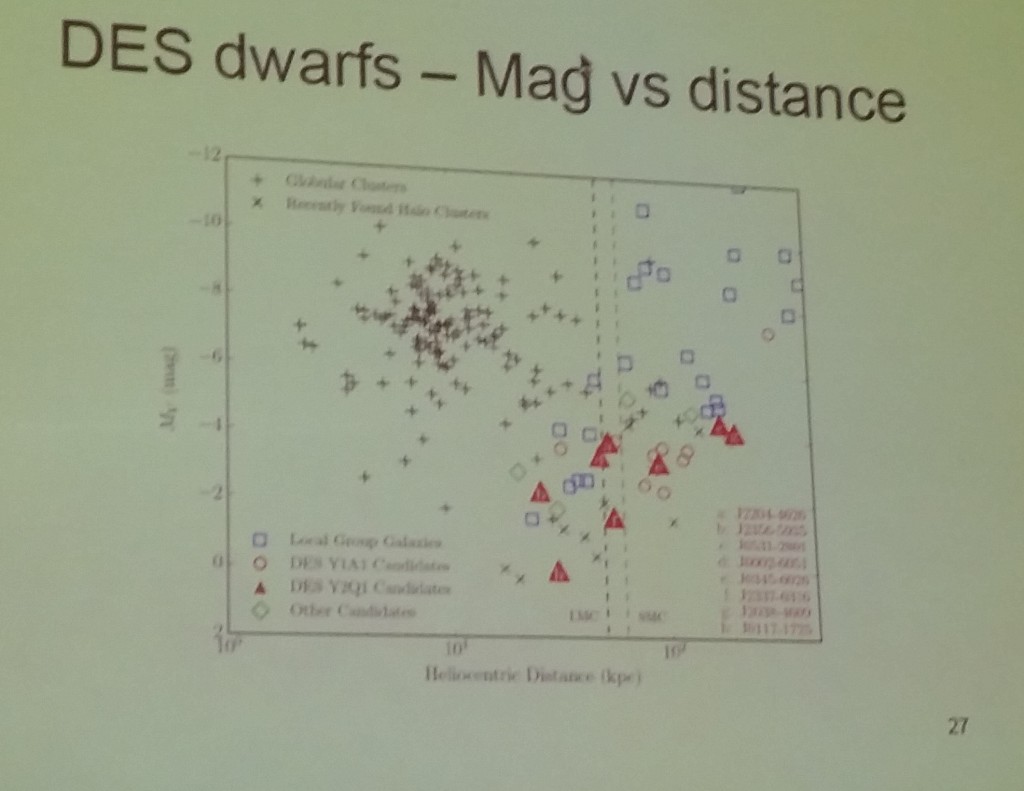
Jimenez: Do we Understand the Universe?
- Standard rulers, calendars, and clocks
- Interesting MCMC model that uses SN data, BAO, and elliptical stellar ages as clocks.
- Constrains BAO length scale, Hubble constant, and curvature without assuming LCDM.

Rephaeli: Galactic Energetic Particles and Their Radiative Yields in Clusters
- Re-acceleration of protons is needed to explain the radio halo in the Coma and other clusters.
- In clusters with no strong radio galaxies, energetic electrons from star forming galaxies can account for extended radio emission at ~3 x 10^39 erg/s.
Amati: Shedding light on the dark Universe with Gamma-Ray Bursts
- Use GRBs to measure the cSFR and the host galaxy metallicities through absorption spectra.
- THESEUS: Proposed ESA space mission to focus on detecting high-z GRBs (launch date ~2030; PI Amati). Goal of ~300 GRBs/yr at z>6. Will have spectroscopic capabilities.
- Additionally, THESEUS will also probe soft X-ray transients (e.g. TDEs)
Sazonov: Preheating of the Universe by cosmic rays from primordial supernovae at the beginning of cosmic reionization
- Exploring the idea of cosmic rays produced in Pop III SN as the blastwave propagates through the nearby IGM.
- For a minimum halo mass of 10^6 Msun and E_SN = 10^52 erg, there is ~40 K of heating and ~0.5% of ionization from cosmic rays. This is assuming that all Pop III stars produce a SN.
- There is a factor of ~10 uncertainty in the low-energy CR production rate.
- Heating and ionization is comparable to X-ray heating but is more compact and dependent on the IGM magnetic field strength.
Schauer: Lyman-Werner UV Escape Fractions from Primordial Halos
- In the near field, no relative velocity (at line center) and use the self-shielding function of Wolcott-Green & Haiman (2010).
- In the far field, they consider the relative velocity (not at the line center), which results in some equivalent width.
- In the near-field, neutral hydrogen through the Lyman transitions can absorb a fair fraction of the LW photons. Can be close to nearly opaque in a 10^7 Msun for a single star.
- Current work: Consider a stellar population in larger halos (10^7 to 5 x 10^8 Msun). See below.
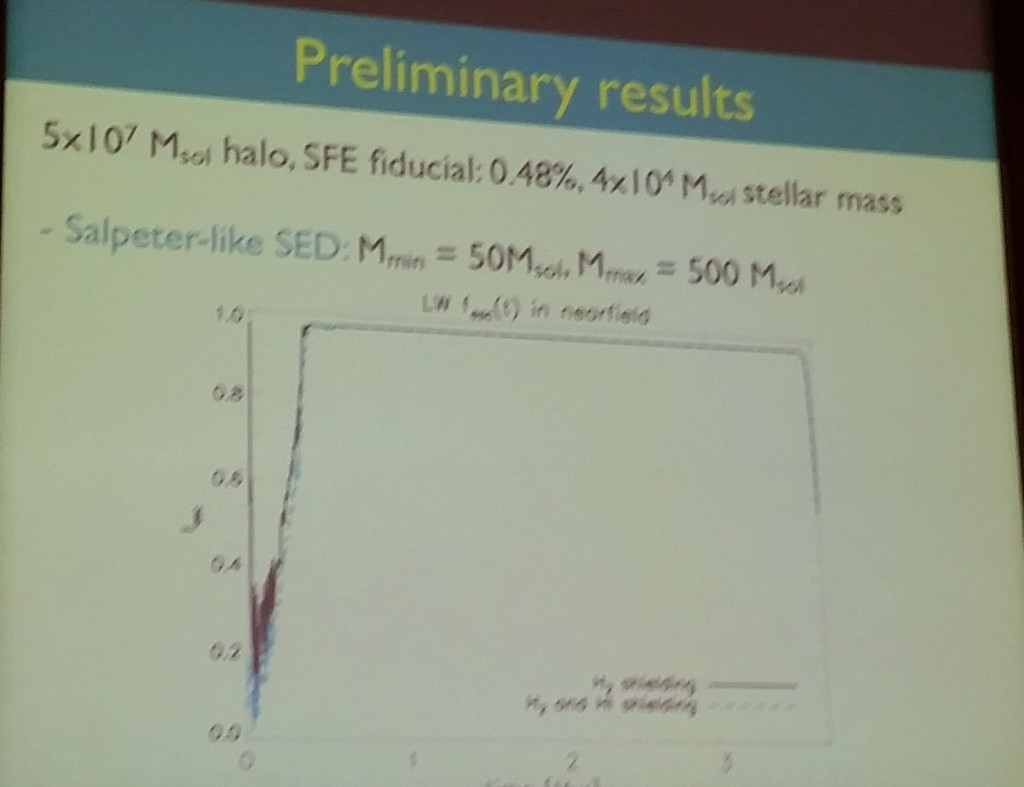

Wandelt: Analysis challenges for cosmological data sets
- (Jasche & Wandelt 2013; Jasche+ 2014) BORG: Bayesian Origin Reconstruction from Galaxies using MCMC and 2LPT for matter evolution.
- Takes observations and produces samples of possible dynamical histories of the Universe.
- Can reconstruct the peculiar velocity field. He showed an example of the inflow onto the Sloan Great Wall.
- (in prep) Simulated the local 300 Mpc/h, initializing the cosmological simulation with BORG and nearby galaxy surveys (SDSS?)
Pritchard: Linking 21cm statistics and astrophysics
- (Liu+ 2015) From Planck, they constrained the mean virial temperature of the first galaxies and their ionizing efficiency. Can further constrain many cosmological parameters with the combination of the CMB and 21cm.
- 21cm observations probe the electron fraction until spin temperature fluctuations become important (Watkinson & Pritchard 2013)
- Can use the global 21cm signal for a consistency check of tau at the low-z end of EoR.
- How to extract astrophysics from 21cm, i.e. brightness temperature?
- Full theory calculation (Mirocha+ 2015)
- Parameterize the physical state of the gas (x_e, T, Lya) (Harker+ 2015)
- Empirical model of observations (Pritchard & Loeb 2010; Bernardi+ 2014)
- (Mirocha+ 2015) Constraints the astrophysical parameters to ~50% from the global 21cm signal.
Mirabel: High Energy Sources in the Reionization Epoch
- Spoke on many aspects on HMXBs from the Milky Way and to the very high redshift universe and reionization.
Greenhill: The Large Aperture Experiment to Detect the Dark Age (LEDA): Results and Prospects
- Great motivation matrix. See below.

- LEDA is taking data now. Can reach a sensitivity of 10 mK in 100 hours with statistical errors, but systematics will dominate the noise.
- Current residuals ~0.4K, which is about 1e-3 of the sky, and they goal is <1e-5 T_sky.
- Science observations after holiday time upgrades: Jan-Mar 2016
- LEDA Gen2: Build next to a VLBA to have imaging cross-correlation.
Whalen: Finding the First Cosmic Explosions
Semelin: How much physics do you need to model the 21 cm forest?
- No evidence for contribution to the 21cm global signal from virialization shock heating (cf. Kaurov & Gnedin 2015).
- Ly-alpha coupling is a key factor to consider. Should be included in the calculation when analyzing simulations.
- Modeling X-ray self-shielding: spectral index of 1.6. Overdense regions are self-shielded and increases τ_21 values.
- There is also some self-shielding from Ly-alpha coupling. Scattering in the wings leads to self-shielding.
Ocvirk: Cosmic Dawn (CoDa): the First Radiation-Hydrodynamics Simulation of Reionization and Galaxy Formation in the Local Universe
- By scaling their results by (z/1.3), they can match observations of cSFR, luminosity functions, optical depth, and ionizing background.
- Reionization suppresses SFR in halos with M < 3 x 10^9 Msun, but it slowly decreases from z=15 to z=5 by a factor of 1000.
- 10^10 Msun halos dominate the ionizing photon budget at z > 10.
- Transition from dark to luminous halos occurs between log M = 8.5-9. Larger dark halos most likely have a massive neighbor.
Zaroubi: Upper limits on the EoR from LOFAR
- Systematic errors (upper limits) are around 20 mK after 155 hours, a small subset of the experiment. This is in the redshift range 7.5-10 at k ~ 0.05 Mpc^-1.
- Soon LOFAR will have 2000 hours.

